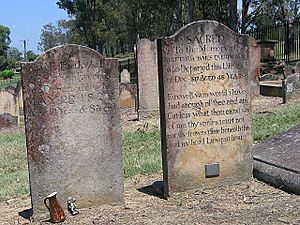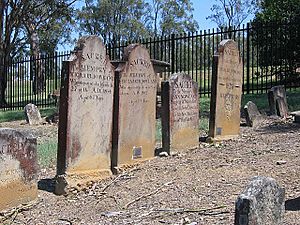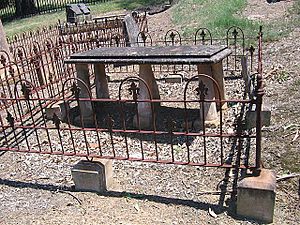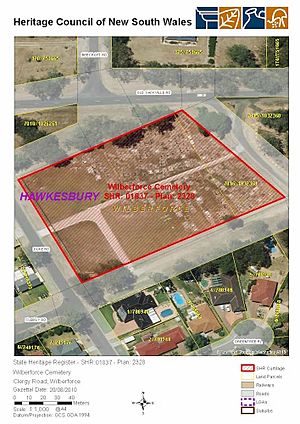Wilberforce Cemetery facts for kids
Quick facts for kids Wilberforce Cemetery |
|
|---|---|
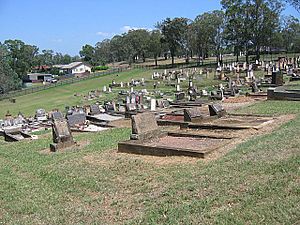
Wilberforce Cemetery, taken from the south east
|
|
| Location | Clergy Road, Wilberforce, City of Hawkesbury, New South Wales, Australia |
| Built | 1811– |
| Architect | Surveyor James Meehan |
| Owner | Hawkesbury City Council |
| Official name: Wilberforce Cemetery; St John's Church of England Cemetery | |
| Type | state heritage (landscape) |
| Designated | 20 August 2010 |
| Reference no. | 1837 |
| Type | Cemetery/Graveyard/Burial Ground |
| Category | Cemeteries and Burial Sites |
| Lua error in Module:Location_map at line 420: attempt to index field 'wikibase' (a nil value). | |
Wilberforce Cemetery is a very old cemetery in Wilberforce, Australia. It is a special historical place. Surveyor James Meehan planned it, and it opened in 1811. It is also known as St John's Church of England Cemetery. The Hawkesbury City Council now owns it. This cemetery was added to the New South Wales State Heritage Register on 20 August 2010 because of its important history.
Contents
A Look Back: History of Wilberforce Cemetery
The First People of the Land
Before European settlers arrived, the Darug people lived in this area. They were Aboriginal people who lived from Botany Bay to the Blue Mountains. They lived in small groups, hunting and gathering food. They built simple homes from bark.
How Wilberforce Town Began
In 1810, Governor Lachlan Macquarie decided to create five new towns along the Hawkesbury River. These towns, including Wilberforce, were meant to be safe places during floods. They would also help organize the growing colony.
Wilberforce became a town with many small farms. It was not easy to reach, so it did not attract very large landowners. Many families of freed convicts settled here, and their families grew over time.
Creating the Cemetery
Governor Macquarie chose the spot for Wilberforce on December 6, 1810. He asked Surveyor James Meehan to plan the town. On January 5, 1811, Meehan set aside two acres for a burial ground.
Macquarie wanted all people to be buried in special, consecrated (blessed) grounds. He ordered this on May 11, 1811. Before this, people often buried their loved ones on their own farms. The local settlers helped build a fence around the new burial ground.
Early Burials and Important People
The first known burials in Wilberforce Cemetery were three men who drowned in December 1811. Their exact graves are not known today. The oldest known grave belongs to Margaret Chaseling, who was buried in 1815. Anthony Richardson, who arrived in Australia on the Second Fleet, was buried in 1816. His grave marker is the oldest one still standing.
A school and a chapel were built nearby. This showed Governor Macquarie's idea of having a church, school, and burial ground together on high ground. This was meant to bring order and religion to the town.
Growing Over Time
The cemetery started with about two acres. For many years, burials were recorded in a different church's register. A separate record for Wilberforce Cemetery began in 1826.
Many early settlers, including former convicts from the First, Second, and Third Fleets, were buried here. Their families often joined them later. Wilberforce Cemetery has more burials of early ex-convict settlers than any other cemetery from Macquarie's time. This makes it very special.
Even though it was a Church of England cemetery, people from other religions were also buried there. Over the years, the cemetery grew with new sections added in the early 1900s.
Who Manages the Cemetery Now?
In 1968, the cemetery's control was given to the local council. It stopped taking new burials in 1986. However, some families still have the right to be buried there, so a few new burials happen occasionally. Today, the Hawkesbury City Council looks after the cemetery.
In 2003, a researcher found that 1,317 people had been buried there. There are 460 headstones, and 842 burials are marked. She also found three people from the First Fleet, ten from the Second Fleet, and four from the Third Fleet buried in the cemetery.
What the Cemetery Looks Like
Wilberforce Cemetery was first laid out as a large rectangle. It had paths that divided it into four sections. These paths are now covered with grass, but you can still see where they were. The cemetery has some gentle slopes, and the paths help manage the changes in height.
The graves are mostly in rows that face east. The older graves are scattered, but many are on the higher ground. Newer graves from the mid to late 1900s are more neatly arranged.
There are no formal gardens or special plants inside the cemetery itself. Trees along the nearby roads help separate the cemetery from the town.
Fences and Gates
An aluminum fence with spear-shaped pickets marks the cemetery's edge. There are gates on the northeast and southeast sides, lining up with the main paths.
Headstones and Monuments
The cemetery has many different styles of headstones, from the early 1800s to the late 1900s. Most of the old ones are upright slabs made of sandstone. White marble is also common. Newer monuments are often made of granite.
The cemetery is special because it has many beautiful "altar style" slabs. These look like small altars. There is also a rare "table style" slab monument for the Robinson family.
Columbarium Walls
Near the eastern entrance, there are two brick walls called columbaria. These were built in the 1970s. They hold urns with ashes. One wall has a plaque honoring members of the First Fleet who lived in the area and are buried in the cemetery.
Condition of the Cemetery
Many of the headstones are in good condition for their age. This shows that the local community has taken good care of them. Some older inscriptions are hard to read because of weathering. Sometimes, new plaques have been added to show the original words.
The cemetery is very old and mostly untouched. This means it holds important clues about early burials and how people were buried long ago.
Why Wilberforce Cemetery is Important
Wilberforce Cemetery is very important to the history of New South Wales. It is one of the first cemeteries created by Governor Lachlan Macquarie in 1810. He wanted to make sure people were buried in special, blessed grounds, not on their farms.
This cemetery is unique because it has the most burials of early ex-convict settlers from the First, Second, and Third Fleets. Many of these people started families who still live in the area today. This makes the cemetery a special place for family history and reunions.
Wilberforce is the only town founded by Governor Macquarie that still has its original church, school, and burial ground together in the center. You can still see how these important buildings were placed on high ground, showing Macquarie's vision for his towns.
The cemetery also has a wonderful collection of old monuments. These include rare "altar style" and "table style" slabs. The work of a famous local stonemason, George Robertson of Windsor, can be seen here.
Because of all these reasons, Wilberforce Cemetery is listed on the New South Wales State Heritage Register. It helps us understand the history and culture of New South Wales.


